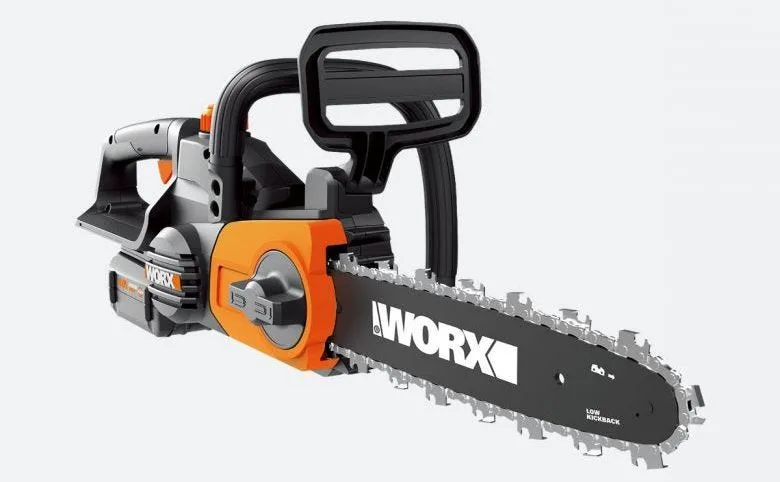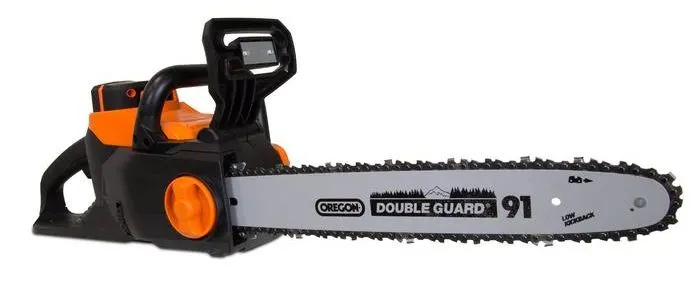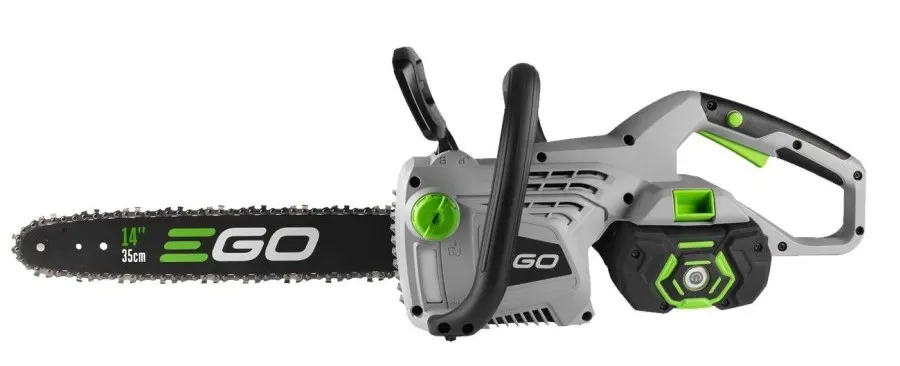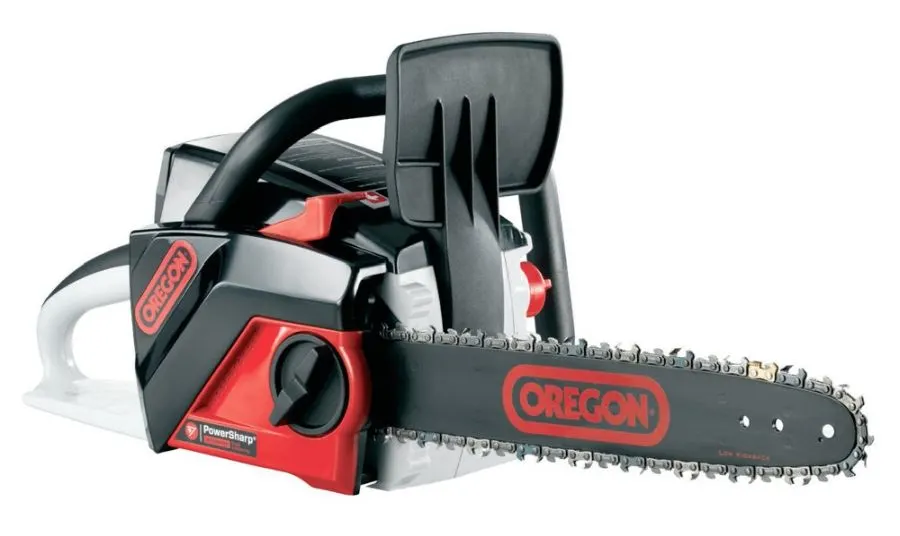Pondering the switch to a battery-powered chainsaw? We’ve scrutinized their performance and reliability. Our research will equip you with the necessary knowledge to determine if they fit your needs.
Cordless electric chainsaws are quiet, lightweight alternatives to gas for home use. Look for long battery life, 14″+ bars, and toolless chain tensioning from top brands. For pro use, choose high amp batteries, 16-20” bars, and a robust build. Compare runtime, motor power, and safety features when researching. Use a sharp chain and protective gear. Maintain as recommended.
Intrigued by the idea of a battery-powered chainsaw? We’ve scrutinized their capabilities and limitations. Learn about the importance of factors like battery life, bar length, and build quality in our comprehensive guide. Equip yourself with the facts and decide if it’s time to go cordless.
Contents
- 1 Which is better? A Gas-powered or battery-powered chainsaw?
- 1.1 ● Pros and Cons for a Battery Powered Chainsaw:
- 1.2 ● Pros and Cons for a Gas Powered Chainsaw:
- 1.3 ● What should I choose, A Gas-powered or battery-powered chainsaw?
- 1.4 ● What is essential when purchasing a battery-power chainsaw?
- 1.4.1 – Electric Chainsaws: Power and Torque of Battery-powered Models
- 1.4.2 – Battery-powered Chainsaw Battery Life
- 1.4.3 – Battery-powered Chainsaw Charging Time
- 1.4.4 When purchasing a battery-powered chainsaw, I always advise consumers to consider the chainsaw’s power, battery life, weight, noise level, and safety features. These factors can greatly affect the user’s experience.
- 1.4.5 – Chainsaw Bar Length
- 1.4.6 – Chainsaw Chain Tensioning
- 1.4.7 – Chainsaw Oiling System
- 2 What are good cordless Chainsaws:
- 3 3. WEN:
- 4 Related Questions:
- 5 Remarks:
- 6 Benefits of Battery-Powered Chain Saws
Which is better? A Gas-powered or battery-powered chainsaw?
Being a homeowner, you might wonder which style of chainsaws suits your needs: gas-powered or battery-powered. The short answer is that it depends on the job you are planning. Knowing the pros and cons of each style can help you make the right choice better.
● Pros and Cons for a Battery Powered Chainsaw:
PROS | CONS |
|---|---|
1. Perfect for smaller jobs | 1. Not suited for cutting large trees. |
2. Provides better spatial maneuverability and can reach tall branches. | 2. The battery usually lasts for an hour, after which it needs charging or a replacement battery |
3. Produces very little noise as compared to gas-powered chainsaws | 3. Not the best choice for large jobs and commercial use. |
4. Very little maintenance is needed as fewer mechanical parts are present. | 4. Relatively lower torque than gasoline-powered counterparts. |
5. Most models are relatively light and easy to carry around. | 5. Spare and replacement batteries are costly |
6. It is gentle on the environment with no emissions. | 6. If you do not have a fast charge option, charging can take quite some time. |
7. They only make a noise when you pull the trigger | |
8. Cheaper to own, due to less maintenance cost and no need for gas. | |
9. Many models use the same batteries also for other garden tools. |
In my years of experience, I’ve found that battery-powered chainsaws offer several advantages over gas-powered ones. They are quieter, lighter, and easier to start and maintain, not to mention the absence of harmful fumes.
● Pros and Cons for a Gas Powered Chainsaw:
PROS | CONS |
|---|---|
1. It is more suited for commercial sawing. | 2. It is pretty noisy, and they make a noise even if you are not cutting. |
2. Easily cut large trees and hardwood planks. | 2. It is quite noisy, and they make a noise even if you are not cutting. |
3. Provides a high torque and rotational speed and thus can cut hardwood with ease. | 3. Requires frequent maintenance due to more mechanical parts. |
4. Downtime is very little as only refueling is needed. | 4. Produces emissions that are harmful to the environment. |
5. Comes with a variety of bar lengths. |
● What should I choose, A Gas-powered or battery-powered chainsaw?
The best choice for you depends on how you use your chainsaw. If you use it often and for extended periods, a gas chainsaw or an engine saw is probably a better choice.
This also applies if you use it more in remote locations. In that case, you can take some extra gas with you and fill the tank when it runs empty.
Of course, you can bring spare batteries with you if you use a battery-powered chainsaw. But when they are empty, you have to stop. If you work with a location with a mains supply, you can charge a battery while using another one and swap them if they are empty.
This will only work if the battery can be charged fast enough.
-Advantages of Battery-Powered Chainsaws
Battery-powered chainsaws like the Craftsman CMCCS620M1 can be excellent for small-scale yardwork. Not only are they quieter and safer, but they also require very little maintenance and thus can serve your needs for a long time. Moreover, their running cost is also low as they require no fuel.
But they are not as powerful as some giant gas chainsaws. If you need power, a gas chainsaw is the better option. This also applies if you need to use a long blade. Almost all battery-powered chainsaws do not work well with long knives.
If you’re looking for an affordable yet productive chainsaw, the CMCCS620M1 battery-powered chainsaw could be a good option. It has a decent cut capacity and is easy to handle. However, always bring spare batteries if you plan to work for extended periods.
● What is essential when purchasing a battery-power chainsaw?
– Electric Chainsaws: Power and Torque of Battery-powered Models
All cordless chainsaws use an electric motor and a battery, but that does not mean they all have the same power and torque. The electric motor specification and the battery voltage determine what the chainsaw can do.
From the chainsaw specification, this is hard to see. Of course, the battery voltage and the rpm of the chain can help with this, but there is no specific number you can use to compare the different models. Try to find an honest review from somebody that used the model.
– Battery-powered Chainsaw Battery Life
The battery life is also an essential factor. How important this is for you depends on your job type. If you see numbers for a specific model, know these are measured under ideal conditions.
The actual number depends on the battery’s age, temperature, and how much power you need from your chainsaw. If you request more power from your saw, the battery will last shorter. But also know that you do not always have the chainsaw on. Only when you pull the trigger will the motor use the battery.
– Battery-powered Chainsaw Charging Time
If you use your chainsaw for more extensive jobs, the charging time can be a significant factor. When the battery is empty, do you need to wait for less than an hour, or does it take almost a day to recharge it?
In many cases, you will have a spare battery that you will use when the first battery is empty. When you swap the battery, you will put the empty one in the charger. If the charger is fast enough, you can swap it again when the spare is empty.
But a fast charge option may be unnecessary if you use your chainsaw only sporadic and for shorter jobs. Often, fast charging will be more costly and put more strain on the battery.
When purchasing a battery-powered chainsaw, I always advise consumers to consider the chainsaw’s power, battery life, weight, noise level, and safety features. These factors can greatly affect the user’s experience.
– Chainsaw Bar Length
If you purchase a chainsaw, check the size of the chainsaw guide bar. This will determine what size of logs, branches, and trees you can cut. The best bar length should be around 2 inches longer than the wood you plan to cut.
Of course, you can cut smaller logs with a longer bar, but do not just purchase the chainsaw with the longest bar is not the way to go. Try to match the bar length with the jobs you plan to do. If you use your saw primarily for trimming, you can go for a bar length from 8 to 12-inch bar.
If you plan to do a lot of tree cutting or chopping logs, go for a 16 to 18-inch bar.
– Chainsaw Chain Tensioning
For your chainsaw to operate correctly, the chains must have the correct tension. If it is not tight enough it can get detached from the bar. If it is too tight, it can break. You must always check and adjust this before using your saw.
If you use a new chain, it will stretch quickly, and you can expect that it needs tensioning several times.
How the chains need to be tensioned depends on the brand and model. For some, you need a wrench and a screwdriver. Others have a tool-less chains tensioning system.
This means you do not need a tool to tension the chains. These systems are much easier to use when cutting and finding that the chains need tension.
– Chainsaw Oiling System
To keep your chainsaw operating correctly, the chains must be lubricated regularly. This will help keep the motor from severe strain or destroy the chains and bar. There are several methods of how the oil can find its way to the chain.
It can be done with a button that you have to push. Or with an automatic system that lubricates the bar and chain with a constant oil flow. Some automatic systems use a fixed amount. With others, you can control it.
We advise you to go for a chainsaw with an automatic oiling system. This way, you are sure the bar and chains are always adequately lubricated. And you only have to ensure enough oil in the tank and the system is not clogged.
What are good cordless Chainsaws:
In this portion, we shall compare battery-powered cordless chainsaws sold by the most popular brands in terms of their specifications and performance parameters, such as cutting speed on various wood types, battery backup, and the cost of each unit.
This will help you finalize your choice for the chainsaw model that best suits your needs.
The article lists some battery-powered cordless chainsaws sold by Milwaukee, EGO, WORX, DeWalt, Stihl, and other popular brands and compares their specifications. Regarding cutting speed on various wood types, DeWalt and EGO provide the least cutting time.
Their price range is also relatively moderate. The Milwaukee has the best battery backup and thus can cut for longer durations. The Stihl is the most expensive model and best suited for commercial sawing due to its high-speed and torque motor.
Ryobi and WEN are suitable for a low budget due to their decent specifications at a price range of < 200$.
1. WORX:
The first model that came up was the Chinese-manufactured WORX electric chainsaw. It comes up with a 14-inch chain length driven by a brushless D.C. motor. The model specifications are listed below:
- Bar & Chain: The WORX model has a 14-inch chain length and a chain pitch of 3/8th of an inch. It has a self-tightening chain mechanism.
- Battery: It comes with two 20V and 2.0 Ah Lithium batteries.
- Motor RPM: The model has around 4000-5000 RPMs at no load.
- Cut time: 17.14s (to cut 9 4×4 lumber pieces), 33.1s (to cut 11-inch dia Honey locust)
- Weight: 10.6 lb.
- Sound: 90 dB
Check the details and price here.

2. Ryobi:
Ryobi’s cordless chainsaw is the perfect alternative if you are looking for good specifications at a low price. Vietnam manufactures the product with a 5-year warranty.
- Bar & Chain: The Ryobi uses a 14-inch chain with a 3/8-inch pitch. Oregon has manufactured the bar and chain.
- Battery: It uses a single 40 V and 4 Ah lithium battery, providing a much better run time than the WORX cordless chainsaw.
- Motor RPM: The Ryobi has around 11000-12000 RPMs, 2.5x more than WORX.
- Cut time: 14.11s (for 9 4×4 lumber pieces), 24.1s (for 11-inch dia Honey locust log)
- Weight: 11.4 lb.
- Sound: 99 dB
Check the details and price here.
3. WEN:
WEN electric chainsaw is another handy product that comes with a 2-year warranty. The product specifications are provided as follows:
- Bar & Chain: The WEN uses a 16-inch chain. The chain and the bar are Oregon-built and are manufactured in China.
- Battery: It comes with a 40V 4-Ah lithium-ion battery.
- Motor RPM: The brushless D.C motor spins slightly above 7000 RPM.
- Cutting time: 20.8s (for 9 4×4 lumber pieces), 30.5s (for 11-inch diameter Honey locust log)
- Weight: 12 lb.
- Sound: 99 dB
Check the details and price here.

4. EGO:
Next, we have an electric chainsaw from EGO that comes with a 5-year warranty. Its details are given below:
- Bar & Chain: The EGO model comes with a 14-inch chain. The bar and chain are Oregon-built.
- Battery: It uses a 56V 2.5 Ah lithium-ion battery.
- Motor RPM: Typically ranges from 6000-7000 RPM.
- Cutting time: 12.1s (for 9 4×4 lumber pieces), 16.5s (for 11-inch diameter Honey locust log)
- Weight: 11.4 lb.
- Sound: 92 dB
Check the details and price here.

5. Husqvarna:
Another chainsaw model with a relatively moderate price is the Husqvarna model 120i cordless chainsaw with a 2-year warranty. The specifications are provided below:
- Bar & Chain: It comes with a 14-inch chainsaw bar. It also has a chain guard.
- Battery: It uses a 40V 4Ah lithium-ion battery.
- Motor RPM: The motor typically runs at 9500 RPM at no load.
- Cutting time: 21.7s (for 9 4×4 lumber pieces), 40.3s (for 11-inch diameter Honey locust log)
- Weight: 10.8 lb.
- Sound: 92.5
Check the details and price here.
6. DeWalt:
A powerful electric chainsaw model built by the American manufacturer DeWalt has been described below:
- Bar & Chain: The DeWalt has a 16-inch chain with a 3/8 of an inch pitch. It also uses a brushless D.C. motor.
- Battery: It uses a 60V 3Ah lithium battery, thus providing a significant backup time.
- Motor RPM: It has around 8000 RPM at no load.
- Cutting time: 10.3s (for 9 4×4 lumber pieces), 15.3s (for 11-inch diameter Honey locust log)
- Weight: 12.6.
- Sound: 99 dB
Check the details and price here.
7. Makita:
The next on our list is the Japanese brand Makita’s cordless chainsaw. It has a power equivalent to a 32-cc gasoline engine. It comes with a 3-year warranty, and Its specifications are provided as follows:
- Bar & Chain: The Makita uses a 16-inch chain bar with a pitch of 3.8th of an inch.
- Battery: Makita comes with two 18V 5Ah batteries with a charge time of 45 minutes. The batteries are lithium made. The batteries and other components are primarily manufactured in China, Japan, and South Korea.
- Motor RPM: It spins at 10000-11000 RPMs at no load. It also uses a variable speed trigger.
- Cutting time: 13.4s (for 9 4×4 lumber pieces), 21.4s (for 11-inch dia Honey locust log)
- Weight: 11.4
- Sound: 98 dB
Check the details and price here.
9. Oregon:
One of the best-built electric chainsaws is from a famous chainsaw manufacturer in Oregon. Its specs are given under:
- Bar & Chain: Oregon uses a 16-inch bar with a built-in chain sharpening system.
- Battery: It is provided with a 40V, 6 Ah lithium battery.
- Motor RPM: Rage from 7000-8000 RPM.
- Cutting time: 16.8s (for 9 4×4 lumber pieces), 25.1s (for 11-inch diameter Honey locust log)
- Weight: 13.4 dB
- Sound: 100 dB
Check the details and price here.

8. Milwaukee:
A powerful chainsaw model from the Wisconsin-based Electric Tool Company is Milwaukee’s M18 fuel electric chainsaw. It provides 20% faster cuts than standard gas-powered chainsaws. Further specs are listed below:
- Bar & Chain: It comes with a 16-inch bar, and the chain has a pitch of 3.8th of an inch. The bar and the chain are Oregon-made and are manufactured in China.
- Battery: Milwaukee has a high-output M18 12 Ah battery and an M18 and M12 rapid charger.
- Motor RPM: It typically spins at 6000-7000 RPM at no load.
- Cutting time: 13.7s (for 9 4×4 lumber pieces), 19.7s (for 11-inch dia Honey locust log)
- Weight: 14.4 lb.
- Sound: 93 dB
Check the details and price here.
9. Stihl:
Lastly, we have one of Stihl’s most expensive and high-end chainsaws, model MSA-220C.
- Bar & Chain: The bar comes with both 14-inch and 16-inch versions.
- Battery: The Stihl comes with a 36V 7.2 Ah battery. The battery has been manufactured in the USA.
- Motor RPM: It spins at 13000-14000 RPMs.
- Cutting time: 14.7s (for 9 4×4 lumber pieces), 18s (for 11-inch diameter Honey locust log)
- Weight: 11.4 lb.
- Sound: 100.5 dB
Related Questions:
1. How long does a battery-powered chainsaw last?
Battery-powered chainsaws can provide a cutting time ranging from 45 minutes to 1 hour. Since, in actual cases, the trigger is not pulled every second, you get several hours of backup time from a battery-powered chainsaw.
2. Are battery-powered chainsaws safer?
Battery-powered chainsaws can be considered safer than their gasoline counterparts since they do not require any fuel, which can cause added safety concerns. However, this doesn’t mean that it’s hazard-free. Care must be exercised while operating chainsaws as they have a sharp spinning chain.
3. Is it safer to use an electric chainsaw in the rain?
Cordless electric chainsaws do not pose any shock hazards since they operate on D.C power. However, you should still avoid using them in the rain as the water might damage the electric circuitry. Corded chainsaws that operate on A.C mains should always be kept away from water to prevent electric shocks.
4. What safety gear should you use while operating chainsaws?
It doesn’t matter what type of chainsaw you are operating; it is always better to be equipped with the appropriate safety equipment. It includes a protective vest, gloves, safety goggles, and some thermal wear if necessary.
Remarks:
For small-scale yardwork, battery-powered chainsaws are a perfect choice. Not only are they quieter and safer, but they also require very little maintenance and thus can serve your needs for an extended period. Moreover, their running cost is also low as they require no fuel.
One thing that you should always pay heed to while operating any chainsaw is the safety aspect. It is better to be safer than be sorry; hence, you should always come prepared with your safety gear.
Maintenance for battery-powered chainsaws is quite different from gas chainsaws. They don’t require fuel mixing or engine servicing, but regular chain sharpening and oiling are still necessary.
Benefits of Battery-Powered Chain Saws
Battery-powered chain saws bear certain advantages versus traditional gas-powered saws. One of the most noticeable perks of a battery-powered chainsaw is its lower noise level. Noise pollution is a legitimate concern when employing heavy-duty tools.
However, battery-powered chainsaws typically function with considerably less commotion compared to their gas counterparts. This quiet execution can benefit homeowners who prefer maintaining a peaceful environment.
Additionally, the maintenance level of these battery-operated tools is relatively lower. Traditional gas-powered saws usually demand high maintenance, often needing regular tune-ups and oil changes. Battery chainsaws alleviate this issue, providing easy, low-maintenance operations.
• Limitations of Battery-Powered Chain Saws
Despite the benefits, battery-powered chainsaws also bear limitations. For instance, they may not be the best choice for large-scale cutting activities or commercial use. They have limited run-time and may require a spare battery for continuous cutting sessions.
Therefore, professionals may still rely on gas-powered types for extensive tasks, while battery-powered chains are more suitable for smaller residential projects.
• Cost-Effectiveness of Battery-Powered Chain Saws
While the initial costs of battery-powered chain saws may seem steep, they can be pretty economical in the long run for specific users. If you already have other outdoor power equipment using the same battery or plan to invest in such, choosing a battery-powered chain saw would be a cost-effective option.
Doing so allows you to interchange the same battery for different tools, saving money on additional purchases. However, prospective buyers should also consider the battery replacement cost, as this requirement can arise during the tool’s lifespan.
• Performance of Battery-Powered Chain Saws
With evolving technology, some battery-powered chainsaws can now match the performance of gas-powered saws. Therefore, considering their efficiency and advantages, they have become viable options for most users.
There are several battery-powered chain saws currently dominating the market. The EGO CS1604, for example, features a unique battery design that helps it stay cooler, thereby extending battery life. Its efficiency during operations and while charging is highly commendable.
On the other hand, the Echo CCS-58V4AH chain saw stands out for its top-cutting speed and ability to make many cuts on a single charge.
Another popular model, the Husqvarna 136Li, does come from a highly respected brand. Despite its average battery voltage and amp-hours, it delivers a decent performance that upholds the respected Husqvarna name.
• Factors to Consider When Choosing a Battery-Powered Chain Saw
Several factors must be evaluated while purchasing a battery-powered chain saw. These factors increase the efficiency of the device and ensure a sound investment.
- Battery and Charger Specifications: Understanding the battery’s voltage, current, and capacity is crucial. These specifications directly influence the performance of a cordless chainsaw.
- Bar Length: The bar length determines how large a piece of wood the saw can cut in a single pass.
- Chain Tensioning: Saws with user-friendly chain tensioning are preferred. These allow for easy adjustments and ensure the chain remains efficient.
- Bar Oil Filling: Look for models that require minimal effort and time for oil refilling.
For further insights on these factors, refer to the detailed guide provided by the Cornell University. It offers a comprehensive breakdown of specifications while selecting power tools for wood-cutting.
• Remarks
With their slew of benefits, battery-powered chainsaws have emerged as a viable option for homeowners and certain professionals.
While deciding on the best fit, one should consider factors like battery specifications, bar length, chain tensioning, and bar oil, and always remember the potential battery replacement cost.
Coupling this strategic thought process with the correct choice can maximize the effectiveness and longevity of your chainsaw.



Can you provide more information on the safety aspects of using battery-powered chainsaws?
Battery-powered chainsaws are ideal for home use, offering quiet operation and low maintenance. Consider factors like battery life and bar length when deciding. Stay safe with proper gear and maintenance.
What are the key differences in performance between battery-powered and gas-powered chainsaws?
Battery-powered chainsaws are ideal for home use with quiet operation and easy maintenance. Gas-powered ones are better for heavy-duty tasks. Consider your needs before choosing.
Why is this article promoting specific brands without disclosing any conflicts of interest? Is this unbiased research or just advertising?
Our in-depth review focuses on performance and reliability, not promotion. We aim to equip readers with the necessary facts for informed decisions.
What are some common maintenance tips for keeping a battery-powered chainsaw in good condition?
Battery-powered chainsaws are quieter and low maintenance. Look for battery life, bar length, and chain tensioning. Explore factors like power, runtime, and safety for research. Always use a sharp chain and proper gear. Maintain as recommended.
Is there a specific brand that is known for having longer-lasting batteries in their chainsaws?
Battery-powered chainsaws like EGO and DeWalt are known for their long-lasting batteries. Consider bar length, battery specs, and maintenance for optimal performance. Happy sawing!
How do battery-powered chainsaws compare in terms of price to gas-powered chainsaws?
Battery-powered chainsaws offer quiet, lightweight options for home use. Key factors include battery life, bar length, and toolless chain tensioning. For professional use, opt for high amp batteries and robust build. Compare motor power and safety features.
Are there any environmental benefits to using battery-powered chainsaws over gas-powered ones?
Battery-powered chainsaws offer a quieter, lightweight alternative to gas for home use. Consider key features like battery life, bar length, and build quality to find one that suits your needs.
Are there any government regulations or guidelines regarding the use of battery-powered chainsaws?
Battery-powered chainsaws are a great option for home use, offering quiet operation and low maintenance. Look for models with long battery life and toolless chain tensioning for convenience. Consider factors like bar length and performance when making your choice.
What are the average lifespans of battery-powered chainsaws compared to gas-powered ones?
Battery-powered chainsaws are ideal for home use with factors like battery life and bar length to consider. Gas-powered saws are better for larger tasks. Consider your needs and choose accordingly.
Can battery-powered chainsaws be used for professional logging and cutting or are they mainly for home use?
Battery-powered chainsaws excel in home use with their quiet, lightweight design. For professional logging, choose higher amp batteries and 16-20” bars. Compare runtime, motor power, and safety features. Always prioritize maintenance and safety.
Is there a reason why the article only focuses on battery-powered chainsaws and not gas-powered ones?
Battery-powered chainsaws are quieter, lightweight, and perfect for home use. Factors like battery life and bar length are crucial considerations. Gas-powered chainsaws are better for heavy-duty tasks. Explore all options before deciding.